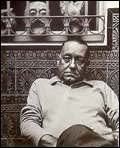Cuban
culture is a combination of Spanish and  African
traditions. The blending of the Spanish guitar and the African drum
gives Cuban music its most distinctive forms, the rumba and the
son. Some of its folk music, however, such as the punto, the zapateo,
and the guajira, has been greatly influenced by European music. African
traditions. The blending of the Spanish guitar and the African drum
gives Cuban music its most distinctive forms, the rumba and the
son. Some of its folk music, however, such as the punto, the zapateo,
and the guajira, has been greatly influenced by European music.
Noted Cuban writers include the 19th-century poets Gertrudis Gómez
de Avellaneda y Arteaga and Julián del Casal and the contemporary
novelists Alejo Carpentier and José Lezama Lima.
 The
National Library in Havana is the largest in Cuba and contains
some 2.2 million volumes. Municipal libraries operate in Havana
and the provincial capitals. The National Museum in Havana houses
collections of both classical and modern art and relics of native
cultures. Other important museums are the Colonial and Anthropological
museums in Havana, the Emilio Bacardi Moreau Museum of natural
history and art in Santiago, and the Oscar M. de Rojas Museum
in Cárdenas. All libraries and museums are under the supervision
of the national government. In addition, Cuban cities support
a variety of cultural activities, such as theater and ballet. The
National Library in Havana is the largest in Cuba and contains
some 2.2 million volumes. Municipal libraries operate in Havana
and the provincial capitals. The National Museum in Havana houses
collections of both classical and modern art and relics of native
cultures. Other important museums are the Colonial and Anthropological
museums in Havana, the Emilio Bacardi Moreau Museum of natural
history and art in Santiago, and the Oscar M. de Rojas Museum
in Cárdenas. All libraries and museums are under the supervision
of the national government. In addition, Cuban cities support
a variety of cultural activities, such as theater and ballet.
For more detailed Cultural Information Visit: www.cubanculture.com
|

